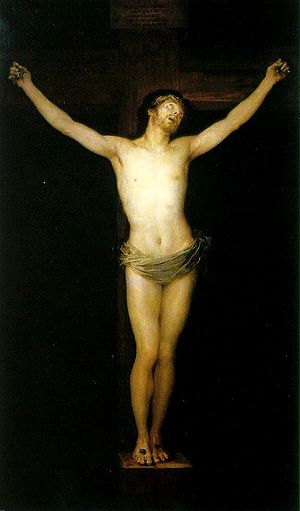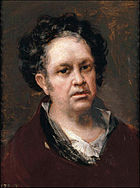- Christ Crucified (Goya)
-
Cristo crucificado 
Artist Francisco de Goya Year 1780 Type Oil on canvas Location Museo del Prado, Madrid Christ Crucified (Cristo crucificado) is a 1780 painting by Francisco de Goya of the Crucifixion of Jesus. He presented it to the Real Academia de Bellas Artes de San Fernando as his entry work as an academician. It now forms part of the permanent collection of the Prado Museum.
Analysis
The painting is neoclassical in style, though rooted in traditional Spanish iconography of the subject and related to the treatment of the same subject by Velázquez (even borrowing its dark black background with no landscape) and Anton Raphael Mengs (borrowing its forward-pushed right leg). Goya obeys the Spanish Baroque iconographic rules for portraying the Crucifixion as laid down by Francisco Pacheco - the black background, four rather than three nails, supported feet and a trilingual inscription at the top of the cross beginning IESUS NAZARENUS REX IUDEORUM. By obeying these rules Goya removed the emphasis on devotional features such as drama and the presence of blood in order to concentrate attention on the painting's soft modelling, since his intention was to please the academicians then dominated by Mengs' neoclassicism.
Worked with loose and vibrant brushwork, Christ's head is lifted and leaning to the left, dramatically looking upwards, possibly in a representation of a gesture of ecstasy as he said "My God, my God, why have you forsaken me?" (Matthew 27:46, Mark 15:34), though the serenity of the painting as a whole avoids a pathetic sensation.
With this work Goya also aimed to show the academicians his work in one of the most difficult areas he possibly could - his knowledge in the area of anatomy - by presenting a nude, justified by being presented in a religious guise in conformity with Spanish tradition. Its technique resolves the difficulty of soft modelling in sfumato as well as the light source (which seems to be Christ's bared breast) and its transition into the dark areas, hiding the outlines of his underdrawing. Transparent areas, glazes and gradations are treated with delicacy in shades of gray and soft green pearl blue, and touches of intense white to enhance the flashes of light. The lines of the composition conform to the sweet classical S allied with the violent effects of the Baroque. The pushed-forward right leg, slightly skewed hip and the tilt of the head give the work dynamic adjustment as demanded by the classical canons to avoid stiffness.
History
As much as his contemporaries admired the painting, it fell out of fashion in the 20th century, when critics preferred to see Goya as a Romantic painter with little or no Catholic faith who paid scant attention to academic or religious painting. However, postmodernism has assessed Goya and his work as a whole, in all its facets, and has taken into account that this is a work in which Goya was still striving for professional prestige.
References
- (Spanish) Ficha del Cristo Crucificado on the online catalogue of the Museo del Prado.
- (Spanish) LUNA, Juan J., Cristo crucificado. [online], in Catálogo de la exposición celebrada en el Museo de Zaragoza del 3 de octubre al 1 de diciembre de 1996, n.º 9: «Cristo crucificado». Cited for the web page Realidad e imagen: Goya 1746 - 1828
- (Spanish) «Cristo crucificado» de Goya, on Artehistoria.
Francisco Goya List of works Paintings Blind Guitarist (1778) • Christ Crucified (1780) • Maria Teresa de Borbon y Vallabriga (1783) • Spring (or The Flower Girls) (1786–1787) • The Swing (1787) • St Francis Borja at the Deathbed of an Impenitent (1788) • Manuel Osorio de Zuniga (c. 1788) • Witches' Sabbath (1789) • Self-portrait (c. 1790–1795) • Little Giants (1791–1792) • Portrait of Mariana Waldstein (c. 1792) • Strolling Players (1793) • Yard with Lunatics (1793–1794) • Marquesa de la Solana (c. 1794–1795) • Duchess of Alba (1797) • Self-Portrait with Eyeglasses (1797) • The Bewitched Man (1797-1798) • The Devil's Lamp (1797-1798) • Witches' Flight (1797-98) • Charles IV in his Hunting Clothes (1799) • Countess of Chinchon (1800) • La maja desnuda • Charles IV of Spain and His Family (1800–1801) • La maja vestida • Bartolome Sureda y Miserol (c. 1803–1804) • Portrait of Doña Isabel de Porcel (1804–1805) • Portrait of Francisca Sabasa García (1804-1808) • Doña Teresa Sureda (c. 1805) • The Colossus (1808–1812; attribution debated) • Majas on a Balcony (c. 1808–1812) • Time (c. 1810–1812) • Prison Interior (c. 1810–1814) • The Second of May 1808 (1814) • The Third of May 1808 (1814) • The Junta of the Philippines (1815) • The Madhouse (1812-1819) • The Inquisition Tribunal (1812-1819) • The Burial of the Sardine (c. 1816) • A Procession of Flagellants (c. 1816) • The Forge (c. 1817) • The Giant (1818) • Self-portrait with Dr Arrieta (1820) • The Milkmaid of Bordeaux (1825–1827)
Tapestry cartoonsThe Parasol (c. 1777) • Blind man's bluff (1789)Saturn Devouring His Son • Judith and Holofernes • Witches' Sabbath • A Pilgrimage to San Isidro • La Leocadia • Two Old Men • Men Reading • Man Mocked by Two Women • Fight with Cudgels • Procession of the Holy Office • Atropos • Asmodea • Two Old Men Eating Soup • The Dog

Etchings The Sleep of Reason Produces Monsters (1797–1798) • What a sacrifice! (1797–1798) • They say yes and give their hand to the first comer (1797–1798) • Que se la llevaron! (1797–1798) • You who cannot (1797–1798)The Disasters of War
(Los desastres de la guerra)TauromaquiaUnfortunate events in the front seats of the ring of Madrid, and the death of the Mayor of Torrejón (1815–1816)Categories:- 1780 paintings
- Collections of the Museo del Prado
- Francisco Goya paintings
- Paintings depicting Jesus
- Paintings depicting death
- Christian death-related art
Wikimedia Foundation. 2010.
